A House Becomes a Home: Inside the New Residence Hall
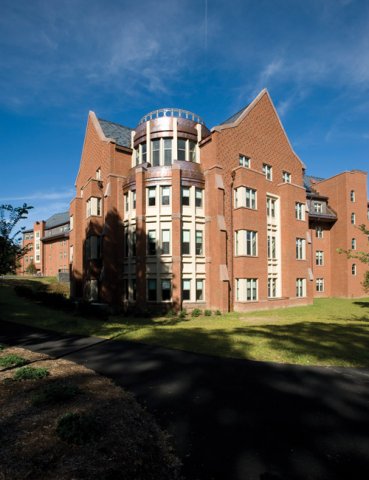
In late August, the first students moved into the first residence hall to be built on campus in more than forty years. The building opened to generally rave reviews (and some complaints as kinks, especially with the One-Card access system, were being worked out). Here’s a peek inside MHC’s newest student quarters.
“ My friends at other colleges are very jealous.”
—Casey Cokkinias ’10

Fast Facts
- The 72,000-square-foot residence hall is divided into two wings joined by a two-story common space.
- It has 176 beds in singles, doubles, and suites (several private rooms sharing common space).
- It’s a “green” building, using 45 percent less energy, and 30 percent less water, than allowed by the already-stringent Massachusetts building code.
- Its environmentally friendly features make the new residence hall a candidate for LEED (Leadership in Energy and Environmental Design) silver certification.For more facts and figures, click here.
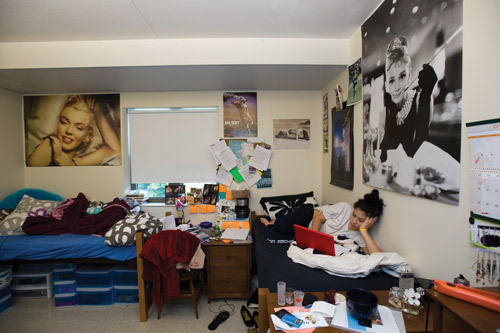

Students give thumbs-up to:
• having their own space, with close friends nearby
• common areas for TV watching, playing pool and foosball
• brand-new furniture
• how modern and environmentally friendly the building is
• the patio, and the view from it,
behind the residence hall
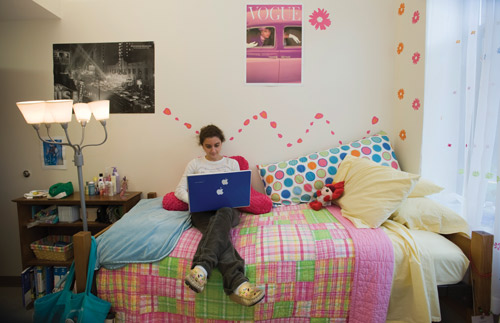
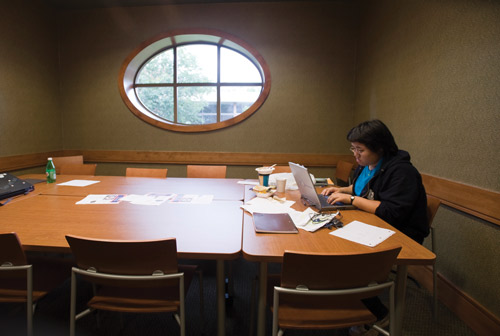
Students give thumbs-down to:
• needing a One-Card to unlock their rooms (Many forgot and got locked out of their rooms early in the semester.)
• the extra minutes required to walk to some academic buildings
• the challenge of creating a close-knit community in a large building

Where is the new residence hall?
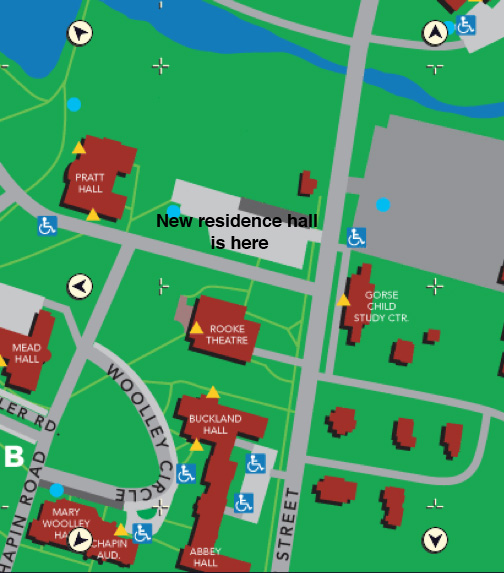
Does the new residence hall have a name?
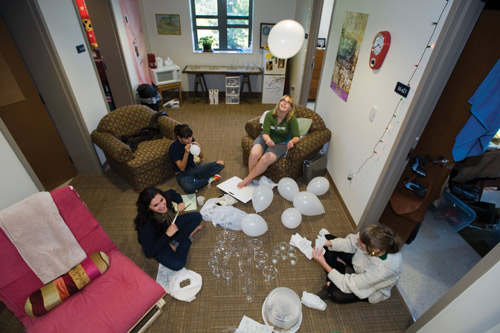

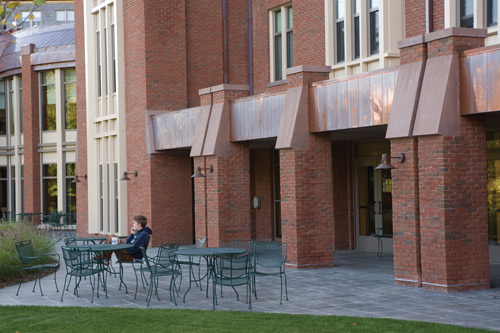
—Photos by Ben Barnhart
This article appeared in the winter 2009 issue of the Alumnae Quarterly.
Learn More: Below, read comments and see photos by Hannah Clay Wareham ’09 about life in the new residence hall. (Additional slide show photos by Ben Barnhart)
New Dorm on Campus: One Resident Shares Thoughts from Her First Semester
By Hannah Clay Wareham ’09
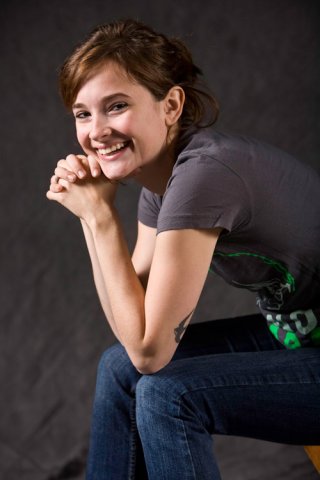 “Moving is hard,” said my fourteen-year-old sister, carrying a shoebox and a pillow toward the new dorm, as she wiped her brow with a free hand.
“Moving is hard,” said my fourteen-year-old sister, carrying a shoebox and a pillow toward the new dorm, as she wiped her brow with a free hand.
I looked at her—a full laundry bag looped over my shoulder, a comforter under my arm, a flimsy cardboard box full of books balanced on my knee, and a floor lamp in my hand—and shifted my weight.
“Yeah, right,” I said, rolling my eyes at her light load, and thanked the gods for the handicap-accessible doors that automatically open with the push of a button.
I walked into her on purpose and we laughed the rest of the way into the building, but stopped short in the lobby.
Sunlight filtered in through the tall windows, playing across the (renewable resource) bamboo floors. Beautiful flowers were arranged in vases along a railing, overlooking a clean, organized dining area below. Not far away, someone was playing the piano. Panels of mottled glass separated us from a cozy and stylish living room, complete with working fireplace.
“It’s like a hotel,” I said, forgetting the weight of the things I was carrying. My sister and I dumped our cargo in a corner and made a beeline for the flat-screen monitor on the wall behind us in the lobby, where a computer supplies up-to-the-minute information on how much energy is being used by the dorm.
The touch-screen monitor inundated us with “green living” facts and we quickly abandoned the machine and headed for the elevator, leaving our belongings behind for Mom and Dad to collect as they came through.
The third floor, while not nearly as awe-inspiring as the lobby, seemed wonderful to me. Easy chairs were positioned near windows overlooking Rooke Theater, and small tables held more flowers. I imagined myself curled up in one of the chairs, wrapped in a blanket and studying fervently, a cup of hot chocolate to cradle in my hands.
The hallway, a labyrinth of turns and dead-ends, eventually led us to my new home, Suite 364. The OneCard-capable lock on the front door slowed me down, but I managed to swipe us into the living room. (Rather than a lock-and-key system, swiping one’s student ID allows access, only adding to the impression of the building as a modern, card key hotel.)
The simplicity, the cleanliness, the space—I was home! Two easy chairs and a table populated the well-lit common room, with windows facing Stony Brook, the ‘Delles barely visible over the trees.
I went straight for the single I had coveted over the summer in the online floor plans—the largest in the suite, a corner room with four windows—hoping beyond hope that Bill Boerner (associate director of residential life) had assigned it to me. The light on the OneCard reader blinked green, and I pushed open the heavy (really heavy) door to my room.
The furniture was standard issue for dorm rooms, but I took an especial pleasure in knowing I would be the first to sleep on this pa
rticular mattress.
In fairly short order, both the common room and my bedroom had become disaster zones, and we had “christened” the room by nicking the wall with a futon frame (then with the bureau, then with a desk). It was quickly beginning to feel more like a home I was used to.
Soon my three suitemates had moved in and were unpacking. The social comfort was instantaneous; two of my suitemates were already close friends of mine, and the third quickly became the same.
It seemed as though we had overestimated the size of our common space, however. Two bed frames stood on end in the middle of the room, and boxes were stacked against the walls. Crossing the room necessitated stepping on futon mattresses, garbage bags of clothes, and milk crates of toiletries, and proved to be a pretty risky venture.
Almost four months later, not much has changed. The boxes are gone, but their contents remain. Coats, papers, DVDs, socks, and empty juice bottles are strewn across the floor of the common room, creating a sort of domestic minefield, the kind of which can only be created by four stressed-out young women, with more homework than time.
The suite hasn’t sustained quite as much structural damage as one would imagine could have been inflicted since Moving Day. The ultra-powerful doors have proven indestructible (and often, impossible to open) due to their weight. Perhaps their thickness deters fire; maybe they are that heavy as a precaution against Amherst’s young men. It takes two industrial-sized doorstops to prop one of the doors open, and even then, they are known to slowly close as soon as one’s back is turned.
Each woman living in the suite has already laid myriad curses upon the OneCard reader guarding her respective door. It is deceptively easy to forget a OneCard in the middle of the night en route to the bathroom, and return to find one’s door locked. Each mishap necessitates a call to Public Safety and a $15 lockout fee. One weekend was particularly brutal, as my suitemate Katy found herself locked out a grand total of four times.
The exterior of the new dorm is architecturally stunning, but overshadowed by a tangled mass of bicycles chained to racks and, more often than not, to one another. A second set of bicycle racks was quickly installed but fails to do more than spread out the disorder.
Since moving in, I haven’t been able to utilize all the wonderful amenities in the new dorm. In true Mount Holyoke fashion, my suitemates and I have been too busy with schoolwork and extracurriculars to utilize the billiards or foosball tables, or even find a quiet moment by the fireplace. Somehow, though, the simple knowledge that we could do these things (and plan to during J-Term) makes our residence in the new dorm seem that much more privileged and dignified, and becomes one more thing to brag about to those less fortunate, students who are forced to live in 1837 or Torrey, rather than in the brand-new “Holiday Inn.”
Facts About Mount Holyoke’s New Residence Hall
This past August saw the opening of Mount Holyoke College’s first new residence hall in forty years. Construction began on the 72,000-square-foot, 176-bed building back in November 2006.
Building Structure and Features
- The complex is separated into two main buildings (the north side occupies one-third of the building’s space, with two-thirds of the space in the south side) joined by a two-story common space. The first level of this centralized connector houses the main entrance, lobby, formal living room, computer room and meeting room. The ground level includes a continental-breakfast area, lounge/game room, and “Golden Pear” (kitchen/dining area that can be reserved by students).
- The building features traditional architectural elements that mesh visually with the 100+ year-old iconic residence halls around Skinner Green. It contains six student “clusters” (with thirty-three students per student advisor), each with a common space (lounge, kitchenette), bathroom facilities, and varied housing arrangements, including singles, doubles, and suites. Other features include in-ceiling and in-floor radiant heat, individual room-temperature control, 100 percent wireless network coverage, card access to all student rooms, and fully ADA-compliant accessibility.
- The building is situated to take full advantage of views both west to Woolley Circle and east to Stony Brook and Lower Lake Dam. The rear terrace overlook has views of the brook.
- The southwest corner rotunda strengthens/identifies the secondary campus entrance at Morgan Street and Lower Lake Road and better connects the southern portion of campus to Gorse parking lot.
Environmental stewardship has always been important to Mount Holyoke, and the “green” building methods used in this project reflect this philosophy. A “silver certification” candidate under the LEED™ program of the United States Green Building Council, the building features:
• Energy efficiency—uses 45 percent less energy than allowed by Massachusetts code
• Solar hot water system generates 25 percent of annual hot water needed
• Green Power—the project has purchased two years of renewable (wind, solar) power.
• Water efficiency—uses 30 percent less water than allowed by code
• Synthetic roof slate shingles made from high-recycled-content materials
• 20 percent materials manufactured locally
• 93 percent of construction waste was recycled
• Energy-efficient lighting
• CO2 monitoring
• Low VOC (volatile organic compound) levels in paint, sealants, adhesives.
• “Green Touch Screen” interactive energy monitoring display
• Renewable bamboo and cork flooring
• LEED™ – points also earned for: Storm-water management, light-pollution reduction, reduced site disturbance, no HCFCs (they are related to ozone depletion); high-recycled-content materials.
[This information was provided by John Bryant, MHC director of facilities planning and management.]
Video: View the Campaign for Mount Holyoke video about the new residence hall here.
January 27, 2009







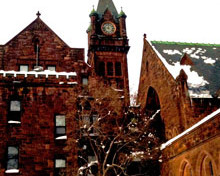
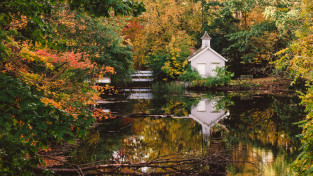
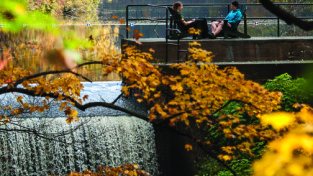
your post makes me miss college (some things at least)